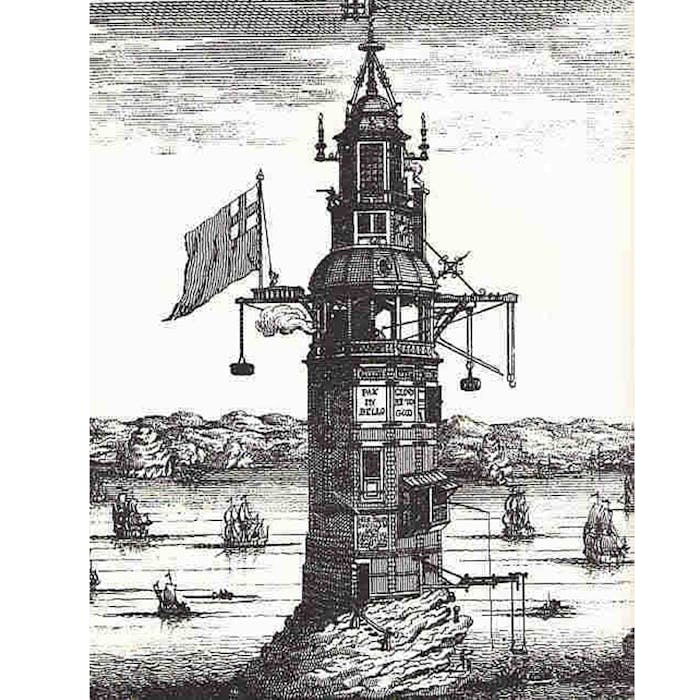
The First Eddystone Lighthouse
The first Eddystone lighthouse was built over three years from 1666 and was a wonderfully eccentric structure. It protected ships until it vanished along with its creator in a great storm in 1703.
The Eddystone Rocks are a very dangerous reef of rocks right in the entrance to Plymouth Sound. At high tide, the whole reef is completely submerged and hidden. In the days of sailing ships these rocks presented a great danger to all shipping. The Atlantic currents cause great swirls and eddies which give the reef its name.
Henry Winstanley, who was born in Essex in 1644, was a successful inventor and businessman. He became wealthy and eventually owned shares in five ships. When he lost not one but two of these on the Eddystone Rocks, he was determined to do something about this maritime menace.
He came to Plymouth and discovered that it was generally agreed that what was needed was a permanent light to warn sailors of the lurking dangers.
In 1696, using his own money, Winstanley began to build the first off-shore lighthouse ever known. It was clearly an enormous challenge, and Winstanley had no real engineering experience. However, for a time, hard work and determination won through.
Another complication, if more were needed, was that England was at war with France. Two years in, Winstanley and his men were captured by a French privateer and taken to the King of France. However, hearing of their work on the lighthouse, Louis XIV ordered Winstanley's release with the words "France is at war with England, not with humanity".
On 14th November 1698, Henry Winstanley climbed to the top of his structure to light no less than 60 candles. But the weather worsened and next day, all those who had shared in the triumph of the opening day found themselves marooned in the Lighthouse where they were forced to stay for another five weeks. They were taken off just three days before Christmas when nearly all their food had gone but none the less, they were relieved because the structure had withstood some very bad storms.
The lighthouse survived its first winter but was in need of repair, and was subsequently changed to a 12 sided stone clad exterior on a timber-framed construction with an octagonal top section.
As the work was completed, Winstanley couldn't resist adding all sorts of architectural delights. The lighthouse had upper galleries and cranes to lift goods off ships. It had ornamental candlesticks on the walls and a chute for rolling stones at intruders to defend the landing place. The outer walls were decorated with symbols and the inscription "Glory be to God".
The following year was a triumph for Winstanley. Little repair work was necessary; there had been no wrecks for two years and the light became famous among all sailors using the Channel. The problem appeared to be fixed.
Winstanley went home, saying to critics that he was prepared to go out to the lighthouse himself and stay there during the worst possible weather conditions because he believed so strongly that the structure would stand.
He kept his word. In 1703, a terrible storm broke over a wide area of England. Winstanley travelled to Plymouth and in a lull of the storm, set out for the Eddystone on Friday 26th November 1703 to conduct a survey. When he got out there, he made a quick check which seemed to satisfy him before settling in to sleep for the night. Before leaving the shore, he had expressed a wish that "he may be there during the greatest storm that ever blew, that he might see the effect it should have upon the structure."
Sadly, he got his wish.
In the early hours of November 27th 1703 , an even more violent storm blew in from the Atlantic.
When the people of Plymouth looked towards the rocks when daylight came, no trace of the marvellous lighthouse or its creator could be seen. Henry Winstanley, his clerks, the three keepers and the house on the rocks were never seen again.
Further reading
Links to external websites are not maintained by Bite Sized Britain. They are provided to give users access to additional information. Bite Sized Britain is not responsible for the content of these external websites.
